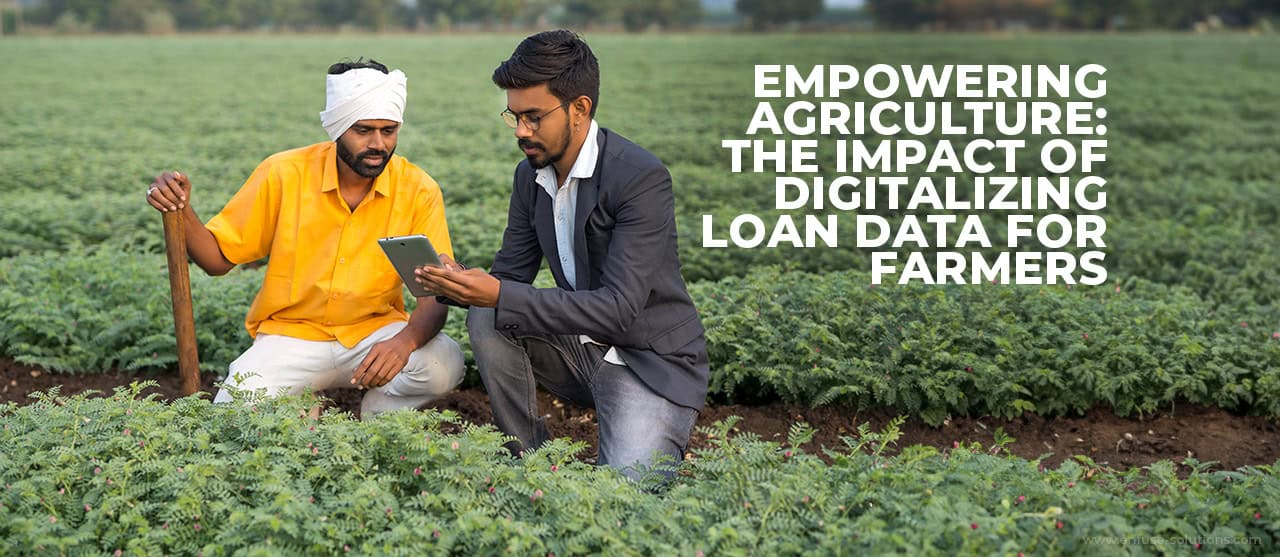
In the heartlands where fertile fields stretch as far as the eye can see, agriculture remains the backbone of communities, economies, and sustenance worldwide. However, the age-old profession of farming faces contemporary challenges that demand innovative solutions.
One such revolutionary facet is the digitalization of loan data for farmers, a paradigm shift that holds the promise of elevating agricultural practices to new heights. This article explores the profound impact of digitalizing loan data on farmers, delving into the multifaceted ways in which this technological intervention is poised to transform the agricultural landscape.
The Current State Of Agricultural Loans
In the landscape of agricultural finance in India, the Primary Agricultural Credit Society (PACS) stands as a crucial component, constituting the lowest tier of the three-tier short-term cooperative credit (STCC) system. With approximately 13 crore farmers as its members, PACS plays a vital role in providing financial support to the agricultural sector.
In a significant move to enhance the efficiency of PACS and bring transparency and accountability to their operations, the Cabinet Committee on Economic Affairs, chaired by Prime Minister Narendra Modi, approved the computerization of these societies in June 2022. This ambitious project aims to computerize about 63,000 functional PACS over five years, with a total budget outlay of Rs 2,516 crore, of which the central government’s share is Rs 1,528 crore.
As part of this initiative, the Ministry of Cooperation (MoC) is also developing model bylaws for these societies, expecting states to adopt them. The government has set a target of establishing 3 lakh PACS across the country, including rejuvenating defunct societies. As part of this comprehensive initiative, PACS members are also poised to receive additional benefits, including the universal computerization of these societies and the issuance of Kisan Credit Cards to all farmers.
Micro-credit facilities from the National Bank for Agriculture and Rural Development (NABARD) are also envisioned, adding a layer of financial support to empower farmers across the country. This concerted effort reflects a commitment to transparency, accountability, and inclusive financial practices within the Indian agricultural sector.
Digitalizing Loan Data
1. What Is the Meaning Of “Digitalizing Loan Data?”
Digitalizing loan data is switching from conventional, paper-based record-keeping to an electronic format and using technology to improve the efficiency and speed of the lending process. This transition includes the collection, storage, and analysis of critical information about farmers and their agricultural operations, which will ultimately revolutionize how loans are sought and handled.
2. Collection And Analysis Of Farmer-Related Information
Instead of relying on manual data entry and paperwork, digital platforms facilitate the automated gathering of pertinent details. This includes comprehensive data about the farmer’s financial history, land holdings, crop yields, and other relevant metrics. The utilization of advanced analytics tools further empowers lenders to derive actionable insights from this data, enabling more informed decision-making in the loan approval process.
3. Integration Of Technology In The Loan Application Process
Digital platforms enable farmers to submit loan applications online, providing a convenient avenue for seeking financial assistance. These platforms often feature user-friendly interfaces, making the application process more straightforward for farmers, even those with limited technological literacy.
Moreover, technology integration allows for real-time tracking of the loan application status, keeping farmers informed about the progress of their requests. This transparency fosters trust between lenders and borrowers while reducing uncertainties associated with the often-prolonged traditional loan approval timelines.
Impact On Farmers
1. Improved Access To Credit
Banks and other lending organizations may now process farmer loan applications more quickly and with confidence that the required information is correct and current thanks to the digitization of loan data. This helps to guarantee farmers’ success by making it considerably simpler and quicker for them to obtain the capital they need for their operations.
2. Increased Transparency
Digitalizing loan data gives both farmers and lenders a more transparent view of the loan process. It also provides more detailed records of a borrower’s financial situation, making it easier for lenders to monitor and analyze their financial performance over time.
3. Reduced Paperwork
Digitalizing loan data minimizes the need for paperwork and manual data entry, allowing farmers to obtain financing more quickly and easily. This also minimizes the need for expensive staff and office space, giving farmers more time and resources to focus on their operations.
4. Better Financial Planning
Farmers can easily track their loan applications and their loan details, allowing them to better plan for their farms’ financial future. Additionally, farmers can use the loan data for tax and budget planning, helping them manage their farms more effectively.
5. Overall Quality Of Life
Reduced paperwork and simple financing availability allow farmers to devote more time and effort to farming, their primary activity. Farmers can take greater pleasure in their daily lives as a result, which gives them more time to unwind and spend time with their families.
Challenges And Concerns
1. Data Collection And Digitization Of Data
Farmers often possess diverse data sets, including land holdings, crop yields, and financial histories. The process of aggregating and transforming this information into a standardized, digital format requires careful consideration to ensure accuracy and completeness.
2. Validity Of Data
Often, data is collected in small, non-standardized fields. As a result, important information may be left out or classified incorrectly. Inaccurate data about a farmer’s agricultural output could lead to inaccurate repayment forecasts that would jeopardize the success of future business transactions with the same lender.
3. Data Privacy Concerns
As loan data becomes digitized, concerns about the privacy of sensitive farmer information such as crop yields and financial histories could emerge. At the same time, there is a risk that loan data could be misused by outsiders, including competitors or by individuals seeking personal financial gain.
4. Digital Literacy And Access To Technology
Disparities in digital literacy and technology access present substantial hurdles, particularly for farmers in remote or underserved areas. Such farmers may be unable to benefit from online services that require access to the Internet, including the online application process.
5. Resistance To Change Among Farmers And Rural Financial Institutions
Some farmers and rural financial institutions are hesitant to adopt new technologies or agree to new directives. There is a misconception that digital technology is complex and burdensome. Also, there are concerns about the potential for new technologies to be used in ways that may not meet the needs of farmers or rural financial institutions.
Wrapping Up
At the nexus of technology and agriculture, the digitization of loan data presents itself as a game-changer, with the potential to drastically improve farming practices. This investigation into the effects of digitizing loan data has shown how agriculture may be improved by resolving issues, promoting financial inclusion, and opening doors for farmers all around the world to have a more prosperous future.
If you want to fully capitalize on the digital revolution in agriculture, think of EnFuse as your guide through these obstacles. With our proficiency in offering comprehensive digital solutions to address intricate business problems, EnFuse is prepared to empower organizations. To get started, get in touch with us.

















Comment